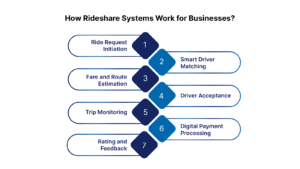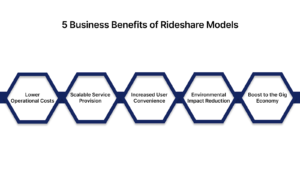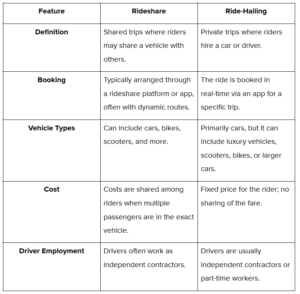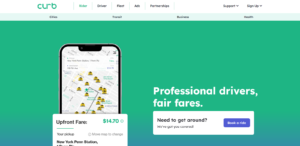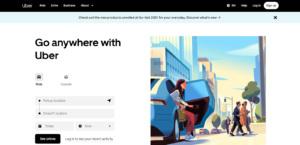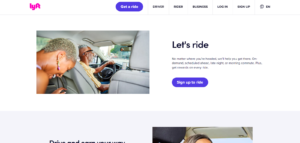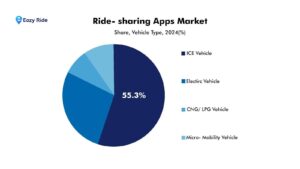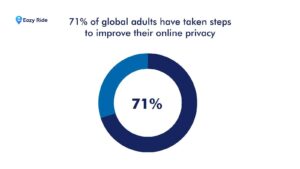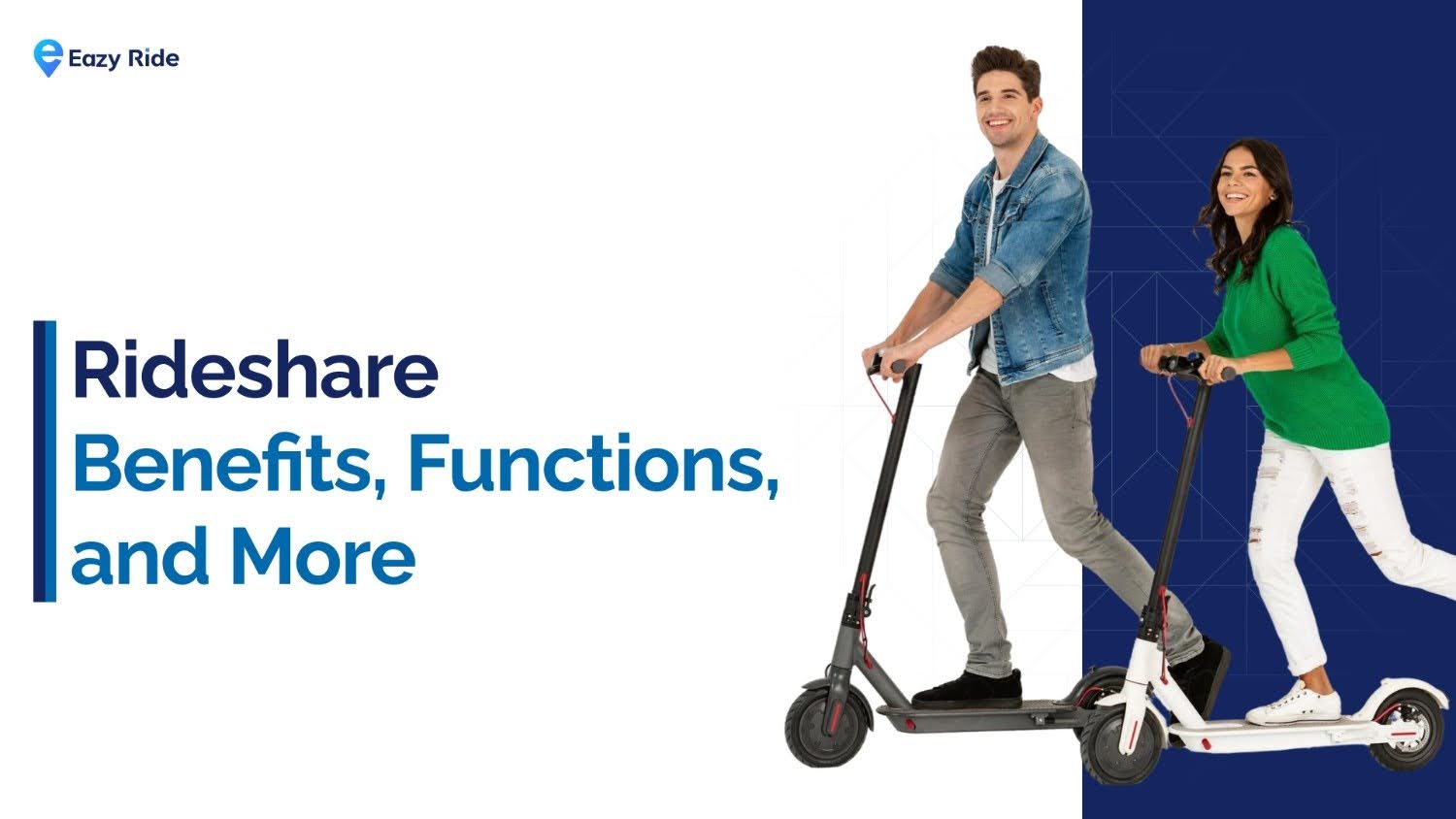 AllMicro Mobility Model
AllMicro Mobility Model
What is Rideshare? Benefits, Functions, and More
Why own a fleet when you can ride the future?
Leasing ties you down. Owning bleeds your budget. Taxis are unpredictable. But ridesharing? It’s flexible, fast, and 100% digital.
Suppose your field team needs to cover five client visits in the US on one day. A traditional fleet needs a driver, route planning, and fuel reimbursement. With ridesharing, they just tap and go on time, every time, with trip data logged automatically.
This isn’t transport. It’s a new era, where your team rides without keys, ownership, or the stress of maintenance. The $341.1 B rideshare industry by 2029 is about changing how the world moves.
As a business leader, you’re likely noticing shifts in commuting behaviour. Employees prefer flexibility. Urban residents avoid car ownership.
Tourists want convenience without rental hassles. Ridesharing fills those gaps. It’s efficient, scalable, and demand-driven, ideal for urban congestion and short-distance transport needs.
In this guide, you’ll learn “what is rideshare”, how it works, and how your business can benefit from this shift.
What is Rideshare?
Rideshare services connect passengers with drivers or vehicles through digital platforms. These rides are often point-to-point and on-demand.
Instead of owning a car, users book rides using apps. This can include cars, bikes, scooters, or vans. Businesses, campuses, and municipalities now use the same model to move people efficiently.
Understanding “what is rideshare” helps you assess its value in solving last-mile delivery or transport gaps. Rideshare services typically offer:
- On-demand trips: Users request rides in real-time through a mobile app
- Flexible routes: Unlike public transit, routes adapt to rider needs
- Shared costs: Riders split expenses when vehicles serve multiple people
- Low overhead: Operators don’t need massive fleets to start
- Scalability: Systems grow based on usage and demand data
In short, it’s a more innovative way to offer transport without high investment or static infrastructure. These services reduce operating burdens, improve accessibility, and meet modern mobility expectations.
So, once you understand ridesharing, its value becomes easier to apply across business or civic operations.
How Rideshare Systems Work for Businesses?
Understanding the backend mechanics of a rideshare system helps you run a smoother, more profitable operation. Here’s how it typically works from a platform perspective:
- Ride Request Initiation: A rider opens the app, sets their pickup and drop-off locations, and submits a ride request.
- Smart Driver Matching: The system uses real-time GPS and driver availability to match the request with the nearest eligible driver.
- Fare and Route Estimation: The platform calculates the expected fare, route, and trip duration using live traffic data and pricing logic.
- Driver Acceptance: The matched driver can choose to accept or decline the ride. Upon acceptance, the rider receives confirmation along with the driver’s details and ETA.
- Trip Monitoring: Both rider and driver track the trip in real time. The platform also monitors progress for safety, efficiency, and support.
- Digital Payment Processing: Once the ride ends, the fare is automatically charged through the app. The platform deducts a service fee before transferring earnings to the driver’s account.
- Rating and Feedback: Riders and drivers provide ratings and reviews. This data supports quality control, driver retention, and fraud detection.
With these systems in place, mobility operators gain far more than just ride coordination. Let’s explore the core business benefits that make ridesharing a scalable, revenue-driving solution.
5 Business Benefits of Rideshare Models
For organizations looking to transport efficiently without owning whole fleets, ridesharing is a proven model. Here are the five business benefits you need to know:
- Lower Operational Costs: Rideshare reduces the need for large fleets, fixed routes, or physical ticketing systems. You only pay for the service used, not for idle capacity.
- Scalable Service Delivery: These systems grow based on user demand, not fixed infrastructure. You can start with limited vehicles and expand using real-time data, without overspending.
- Increased User Convenience: Rideshare platforms offer end-users the convenience of app-based ride requests and flexible routing. This translates into improved user satisfaction.
- Environmental Impact Reduction: Shared rides mean fewer vehicles on the road and lower emissions overall. Rideshare systems support sustainability goals without added complexity.
- Boost to the Gig Economy: Rideshare platforms create flexible income streams for fleet operators. This model attracts talent without traditional employment burdens.
As you consider the benefits of ridesharing, it’s important to distinguish between similar services in the transportation space. In the next section, we’ll explore whether ridesharing and ride-hailing are the same or if there are key differences you need to understand for your business.
Is Rideshare the Same as Ride-Hailing?
Ridesharing and ride-hailing are often used interchangeably, but there are subtle differences between the two. While both are part of the shared mobility ecosystem, they serve slightly different purposes and offer distinct experiences for riders and service providers.
To clarify, we’ve outlined the main differences in the table below. Understanding these distinctions can help you choose the right platform for your business needs.
Top 3 Major Rideshare Companies in the Market
Ridesharing is a competitive space with multiple players offering varying service levels, scalability, and features. For businesses looking to launch their platform or integrate shared mobility into their operations, it’s important to understand the differences between top-tier rideshare providers. Here’s a look at some of the major players in the rideshare market:
1. Curb
Curb simplifies corporate transportation management with features like:
- Unified employee ride tracking and consolidated billing.
- Customizable ride rules and approval workflows.
- Detailed insights into travel patterns and expenses for smarter decisions.
2. Uber
Uber is a global rideshare leader, operating in over 900 cities. Enterprise features include:
- Customized solutions via Uber for Business.
- Ride management with an admin dashboard and consolidated billing.
- API integrations to embed Uber services within internal company apps.
3. Lyft
Lyft is a leading U.S. rideshare service with growing international reach. Enterprise features include:
- Fleet management and analytics to optimize employee transport.
- Integrated expense reporting for easy billing and reimbursements.
- Smooth integration with business systems for efficient ride management.
Rideshare and the Role of Technology
Technology is the backbone of the modern rideshare ecosystem. Core technologies of powering ridesharing are:
- GPS & Real-Time Data: GPS technology is essential for routing, trip tracking, and location-based services. This GPS data is transmitted to a central server through a cellular connection. Real-time data also ensures efficient fleet management, reducing wait times and optimizing routes for drivers.
- Mobile Platforms: Mobile apps connect riders with drivers, simplify payment processes, and increase the overall user experience. These apps are critical to the success of rideshare businesses, providing a seamless platform for riders to book and pay for rides.
- Machine Learning: Machine learning algorithms power predictive demand and dynamic pricing. By analyzing historical data, these systems predict when and where rides will be in high demand, ensuring that supply aligns with demand.
For businesses offering diverse rental options, such as scooters, bikes, and cars, employee travel tools and corporate dashboards become essential.
What You Need to Know About Ridesharing Challenges
Scaling a rideshare business operating across multiple vehicle types, such as cars, bikes, or scooters, presents unique challenges. For instance, ICE vehicles still dominate the market with a 55.3% share in 2024, making it harder for companies to shift towards more sustainable options without facing infrastructure or regulatory hurdles.
While the technology may be in place to support growth, businesses face various obstacles as they expand into different cities or regions, such as:
Regulatory Hurdles
- Different cities and countries impose varying rules on fleet size, parking, safety, and operation hours.
- Compliance across regions can be costly and time-consuming.
- Zoning laws may restrict where scooters and bikes can operate or be parked, limiting business growth.
Data Privacy and Security Concerns
- Rideshare companies handle large amounts of sensitive user data, including location and payment info.
- Secure data handling is essential to avoid legal issues and protect reputation.
- 71% of global adults actively manage online privacy, pushing companies to strengthen security measures.
Driver Satisfaction Challenges
- Managing earnings, benefits, and work conditions is vital to keep drivers motivated.
- High driver churn harms service quality and availability.
Peak Demand Inefficiencies and Pricing Volatility
- Limited vehicle availability during rush hours causes service delays.
- Surge pricing can frustrate customers, affecting loyalty.
- Balancing supply, demand, and fair pricing is an ongoing operational challenge.
How Eazy Ride Helps Overcome These Challenges?
Eazy Ride provides a comprehensive suite of tools designed for efficient, scalable fleet operations across scooters, bikes, and cars. From user experience to backend control, every feature is built to support regulatory compliance, operational ease, and business growth.
- White-Label Rider App
Fully customizable app for iOS and Android with features like in-app wallet, ride history, map integration, and customer support. - Admin Dashboard
Centralized platform for managing pricing, geo-zones, fleet activity, user data, analytics, and promotional campaigns. - Fleet Operator App
Mobile tool for on-ground teams to handle rebalancing, charging, repairs, and vehicle check-ins using QR code scanning. - AI-Powered Analytics & Heatmaps
Track peak zones, trip frequency, revenue, and idle vehicle trends for smarter deployment and performance optimization. - Geofencing & Zonal Control
Define ride zones, no-go areas, parking limits, and speed caps to stay compliant with local rules and enhance safety. - Multiple Business Models
It supports docked, dockless, and hybrid systems, which are ideal for cities, universities, gated communities, and tourism rentals.
Wrapping Up
From lowering operational costs to improving access in underserved areas, rideshare solutions support flexible, scalable transportation strategies. Businesses benefit from data insights and enhanced service quality when partnering with the right provider.
With advancements in GPS tracking, AI analytics, and mobile integration, rideshare technology offers real-time visibility and more innovative logistics. These innovations support smoother employee commutes, improve last-mile delivery, and boost customer satisfaction across industries. That’s why knowing “what rideshare is” is highly useful for business leaders.
Looking to launch or scale your rideshare operations with confidence? Eazy Ride delivers a complete mobility stack, custom rider apps, and AI analytics, built for fast deployment and enterprise control. Book a demo with Eazy Ride to see how your business can move smarter, faster, and with full control.
FAQs
Q1: What is rideshare app?
A: A rideshare app connects passengers with drivers using personal vehicles. It allows users to book rides, track driver location, and make payments, all through their smartphone. Examples include Uber and Lyft.
Q2: What are ride-sharing examples?
A: Common ride-sharing examples include Uber, Lyft, Ola, and Bolt. These platforms allow people to share rides, either individually or pooled, to reduce costs and emissions.
Q3: What is rideshare Uber?
A: Rideshare Uber is a service that lets users book a ride through the Uber app. It connects passengers with nearby drivers for on-demand transportation, offering options like UberX, UberPOOL, and Uber Black.
Q4: What is rideshare insurance?
A: Rideshare insurance is a policy that covers drivers who use their personal vehicle for commercial ride-sharing. It fills gaps between personal auto insurance and the coverage provided by platforms like Uber or Easy Ride.
Q5: What is rideshare pickup?
A: Rideshare pickup refers to the designated location where a driver collects a passenger. Many airports, malls, and offices have specific rideshare pickup zones to manage traffic flow and ensure passenger safety.



